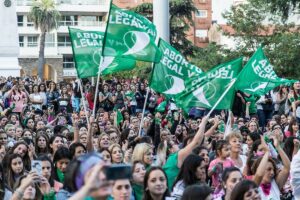Victoria said the Supreme Court leak had caused great concern for feminists in Argentina, though she added: “what the Americans are living right now is not isolated.” While there has been progress in winning legal protections for abortion rights (notably in Mexico), there have also been significant steps backwards, representing what Victoria called a conservative ‘backlash’. In 2020, Brazil introduced new legislation requiring medical staff to inform the police when rape survivors seek an abortion. And in 2021, Poland introduced a near ban on all abortions, limiting access to it except in cases when the pregnancy was caused by an illegal act, such as rape or incest, or when it threatens a person’s health. Just two examples of the kind of reversal she is seeing. In much of the rest of the world, abortion remains completely illegal, with many people being imprisoned for attempting to find abortions in the backstreet, or dying as a result of unsafe conditions.
Victoria argues that a critical ingredient for campaigns to secure access to safe abortion is building alliances, in the first instance, among feminists. A key pillar of Marea Verde’s success, she says, was the alliance of women’s rights activists in Argentina: “It took many years but we saw the coming together of different political generations,” including ‘Pibas’ (teenagers), ‘históricas’ (feminists from older generations who had been most active in the seventies), millennials, immigrant and Indigenous women, and trans people. For Victoria, each of these groups contributed something unique to building the movement. The históricas brought their political experience to help devise political strategy while the pibas helped to mobilise people onto the streets, particularly through social media. When we asked Victoria how organisers built the connections between these diverse groups she recalled a heavy emphasis on inclusive participation:
“We tried to build a very collective strategy. We met once a year to discuss the strategy and our goals – we had one meeting a year with everyone [in a different region of Argentina each time] and then in the regions we had more meetings. That generated a very collective structure. The fact of discussing in big collective ways was very helpful as we could see the point of view of all the activists which made us stronger”
This collective strategy was underpinned by connecting socially, outside organising structures. “We tried to meet each other beyond our role of activists,” explained Victoria. She recalled that groups in the movement organised parties and social events to raise money for travel to the different meetings. And they kept their opponents at the front of everyone’s mind in order to maintain solidarity: “The enemy was so strong that we knew we had to remain united,” she says.
In addition to building solidarity among the feminists, Marea Verde built crucial alliances with other organisations, and individuals. These included human rights organisations, trade unions, doctors and other medical professionals and journalists. “We were very strategic in looking for alliances which could amplify our rights, amplify our arguments and reach more people,” Victoria stresses. Activists would go directly to meet these organisations and “convince them that abortion was a rights issue by showing each organisation and individual how access to abortion related to their particular goals. Once the case was made, these alliances proved invaluable in pushing the movement forward.
Marea Verde also made international alliances with feminist groups across the world, which helped to add pressure as the Argentinian Congress was considering legislation to legalise abortion. Just before key moments of legislative scrutiny, congressional representatives would be flooded with letters and photos from activists from over 100 cities around the world, urging them to pass the law.
While these organising efforts were vital, Victoria argues, she also celebrates the power of a unifying symbol, notably the green scarf, worn by participants of the movement. “The success of the green scarf was amazing,” she says. “Fifteen years ago when the national campaign started not every woman supported the abortion issue so we thought of a way to recognise each other. “The scarf as a symbol already had political significance. White ones were worn by ‘Las Madres de Plaza de Mayo’ [the mothers of children disappeared by the Argentinian dictatorship in the ‘seventies, who mounted a campaign over many years for their children to be found and returned to them]. Marea Verde chose green scarves because green was not associated with any political movement or party in Argentina. It soon became a means for supporters of the movement, not only to find each other, but to watch it grow as more and more people wore the scarf in public. Green posters were used to advertise public protests and demonstrations for abortion rights became a sea of green (giving Marea Verde its name). Many other countries have since adopted the green scarf for their own feminist movements and it has become an international symbol of feminist solidarity.
While Argentina itself still has further to go towards ensuring all those who need abortions are able to access them safely, it’s clear that huge strides have been taken. “Personally I wanted to quit many times.. sometimes I thought we would never do it,” she says, but the unimaginable eventually became imaginable, and then achievable, in the form of the legalisation of abortion rights. US activists have a fight on their hands. However, they may have much to gain from talking with their counterparts in Argentina and Mexico.
You can listen to the full interview with Victoria here: https://strengthandsolidarity.org/podcast/6-argentina-a-stunning-victory-for-women/
Sign up to the podcast newsletter: https://strengthandsolidarity.org/newsletter/
Subscribe to the podcast on Spotify here:
https://open.spotify.com/show/4v7dThW63TS9JpsGf0oQBS
Read more about the Symposium for Strength and Solidarity: https://strengthandsolidarity.org/about/
